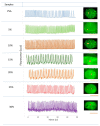In Vitro Modulation of Spontaneous Activity in Embryonic Cardiomyocytes Cultured on Poly(vinyl alcohol)/Bioglass Type 58S Electrospun Scaffolds
- PMID: 38392745
- PMCID: PMC10892114
- DOI: 10.3390/nano14040372
In Vitro Modulation of Spontaneous Activity in Embryonic Cardiomyocytes Cultured on Poly(vinyl alcohol)/Bioglass Type 58S Electrospun Scaffolds
Abstract
Because of the physiological and cardiac changes associated with cardiovascular disease, tissue engineering can potentially restore the biological functions of cardiac tissue through the fabrication of scaffolds. In the present study, hybrid nanofiber scaffolds of poly (vinyl alcohol) (PVA) and bioglass type 58S (58SiO2-33CaO-9P2O5, Bg) were fabricated, and their effect on the spontaneous activity of chick embryonic cardiomyocytes in vitro was determined. PVA/Bg nanofibers were produced by electrospinning and stabilized by chemical crosslinking with glutaraldehyde. The electrospun scaffolds were analyzed to determine their chemical structure, morphology, and thermal transitions. The crosslinked scaffolds were more stable to degradation in water. A Bg concentration of 25% in the hybrid scaffolds improved thermal stability and decreased degradation in water after PVA crosslinking. Cardiomyocytes showed increased adhesion and contractility in cells seeded on hybrid scaffolds with higher Bg concentrations. In addition, the effect of Ca2+ ions released from the bioglass on the contraction patterns of cultured cardiomyocytes was investigated. The results suggest that the scaffolds with 25% Bg led to a uniform beating frequency that resulted in synchronous contraction patterns.
Keywords: Ca2+ bioactivity; PVA/bioglass hybrid; cardiomyocytes; cell contractility patterns; electrospun scaffolds; physicochemical characterization.
Conflict of interest statement
The authors declare no conflicts of interest.
Figures










References
-
- Deaths from Cardiovascular Diseases Surges 60% Globaly on the Last 30 Years: Report. World Heart Federation; Geneva, Switzerland: 2023.
-
- Maria T.M.C., de Carvalho R.A., Sobral P.J.A., Habitante A.M.B.Q., Solorza-Feria J. The Effect of the Degree of Hydrolysis of the PVA and the Plasticizer Concentration on the Color, Opacity, and Thermal and Mechanical Properties of Films Based on PVA and Gelatin Blends. J. Food Eng. 2008;87:191–199. doi: 10.1016/j.jfoodeng.2007.11.026. - DOI
Grants and funding
LinkOut - more resources
Full Text Sources
Miscellaneous

